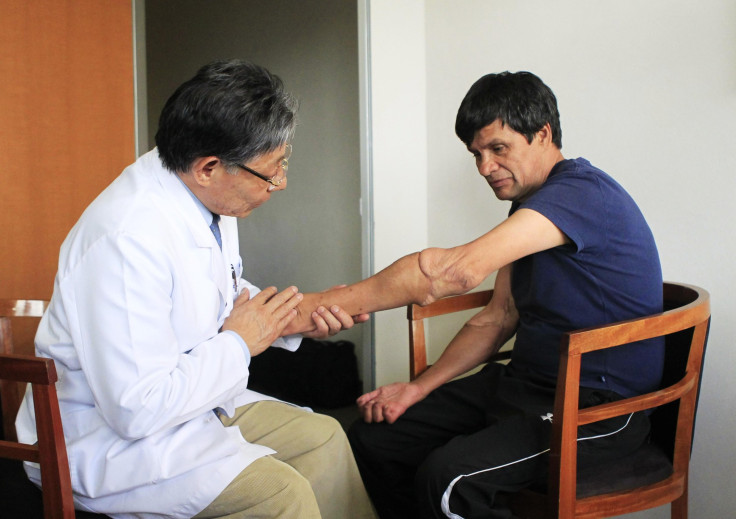Double Arm Transplant: Gabriel Granados Feels 'Terrific' After Receiving New, Functional Limbs From Shooting Victim [VIDEO]

A Mexican man who received a double arm transplant has now begun to feel his hands after losing both his arms from suffering severe electric shock.
Gabriel Granados, a 52-year-old father of two, became the first double arm transplant recipient in Latin America in May 2012. He tragically lost his arms while giving instructions to a group of construction workers building a fence when he was working for the financial unit division of the Mexico City prosecutor's office.
“When the accident happened, I was carrying a piece of rod that caused the electric shock that burned arms, arteries, nerves, vessels, and bone,” Granados said in a June news conference, according to Life Daily.
After undergoing an extensive surgical procedure for a total of 17 hours with 20 doctors, Granados is ecstatic to regain movement in his new functional limbs. The rare double transplant included five plastic surgeons, three anesthesiologists, and five nurses who attached arms that had been donated from a 34-year-old shooting victim at Mexico City's National Institute of Medical Science and Nutrition. Prior to Granados, the doctors had only practiced the procedure on corpses, the Daily News reports.
According to Johns Hopkins Medicine, transplants involving several kinds of tissue like the hand/arm — also known as “vascularized composite allotransplantation” — is complex, as it involves bone fixation, reattachment of the arteries and veins, and repair of tendons and nerves. A newly transplanted limb could be rejected by the body because the tissues are “foreign.” If that happened, the body’s natural response would have been to attack the transplant, which can occur within days to months after the surgery. Spotty, patchy, or blotchy rashes could have appeared anywhere on the transplants if the body begins to reject it.
To prevent the body’s rejection of the new limbs, transplant patients are matched with a donor who has matching blood and tissue types along with matching skin color, skin tone, gender, ethnicity, race, and size of hand.
At the time of Granados' surgery, Mexican doctors noted that there were 23 other patients waiting for arm transplants, although only six could be successfully done. Granados hopes his story will inspire others to become organ donors.
"We unfortunately don't have the culture [f]or organ donation,” said Granados, The Independent reported. "I thought the same, but today I would (donate an organ). This is the proof that it works."
Granados was discharged from the hospital on Thursday after his surgery in May 2012. He is now able to move his new limbs and has regained his independence after almost three years since the accident. Mexican doctors say he has recovered about 70 percent of his arm movement due to intensive daily therapy sessions. This medical breakthrough in Latin American has paved the way to further research on double arm transplants and their success rates.
"This is a very special day for Mexico from a scientific point of view," said Dr. Fernando Gabilondo, director of Mexico City's National Institute of Medical Science and Nutrition Salvador Zubiran, where the procedure took place, according to The Independent.
Recently in the U.S., Brendan Marrocco, a 26-year-old Iraq war veteran, became the first service member to receive two donor arms following a 13-hour operation. This surgical procedure was described as the most complex arm transplant ever performed in the U.S., The Washington Post reported. W.P. Andrew Lee, professor and chairman of the Department of Plastic and Reconstructive Surgery at Johns Hopkins Hospital in Baltimore said, however, that transplanted arms are never going to regain 100 percent of function in the limbs they replace.
Despite losing both arms in unfortunate events, both Granados and Marrocco, have begun to relearn arm movements with their new transplants, and are adapting to a new lifestyle.
To learn more about hand/transplants, click here.



























